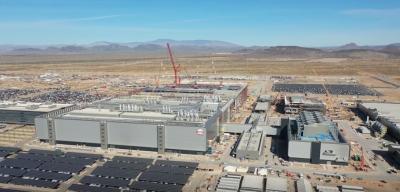In the spring of 2001, the City of Cleveland Department of Port Control (DPC) awarded the Abram Creek Improvement Project to Independence Excavating as part of the major expansion program at Cleveland Hopkins International Airport (CHIA).
The project also has the distinction of being the largest single contract ever awarded to Independence Excavating. The administration of the project began in June of 2001 and actual construction started in January 2002. The scheduled completion is set for mid-year 2004.
The primary purpose of this project was to divert Abram Creek into four 10-ft. (3 m) diameter culvert pipes to allow the new runway to be built over the creek and existing ravine. Abram Creek is a tributary of the Rocky River on the Western portion of the CHIA property. The creek section that is impacted by the project extends north from Grayton Road to just short of Cedar Point Road.
Prior to the start of the project, the creek meandered through a heavily wooded ravine that has an average depth of 65 ft. The protection of Abram Creek has been a paramount concern for the City of Cleveland, Ohio EPA and Independence Excavating.
To protect the creek, the project requires the implementation of one of the most extensive Storm Water Pollution Prevention Plans (SWP3) undertaken in Northeast Ohio. The goal of the SWP3 is to minimize the sediment runoff from entering the creek, a challenging task when the project straddles 3,800 linear ft. of creek.
The major component of the SWP3 is the installation of 2,100 linear ft. (640 m) of 60-in. (152 cm) diameter temporary diversion pipe that carries the flow away from the work area until the permanent culvert is in place. This pipe will be filled with flowable fill (low strength mortar) once the creek is diverted into the permanent culvert. The SWP3 also utilizes many sediment traps that are constructed sequentially as fill is placed in the ravine.
The SWP3 is an ongoing and critical part of the phasing of the work and requires daily inspections to assure all preventative measures are operating properly.
Because this is the largest single contract Independence Excavating has received to date, this is a big project for the company. The job encompasses approximately 400 acres (162 ha) within the CHIA property. Of this area, nearly 200 acres (81 ha) are wooded and require clearing in order to start. The most difficult section of the clearing is 50 acres (20 ha) within the ravine area where in some locations the trees were situated on vertical cliffs 60 to 70 ft. high. Vermillion Tree and Land Clearing was hired to perform this specialized work.
The earthwork on this project is enormous for the Cleveland area. It consists of 3.8 million cu. yd. (2.9 million cu m) of dirt. The bulk of the fill will come from a 39-acre (16 ha), 30- to 40-ft. (9 to 12 m) deep retention pond, which will be located just south of the new runway.
To move this quantity of dirt in a relatively short amount of time, Independence will use a PC1100, a Cat 375 backhoe, a newly purchased Cat 385 backhoe, three or four large bulldozers, compactors, graders and between six and 12 35- and 40-ton (32 and 36 t) off-road dump trucks.
The concrete structure subcontractors, S.E. Johnson Companies and Mohawk Rebar Services, are performing another large item of work. The culvert pipe has three massive concrete structures that divide it into sections.
The first is an Outlet Structure (OS) at the downstream end of the culvert through which the culvert pipes discharge back into the undisturbed area of Abram Creek. The OS is roughly 85 by 70 ft. (26 by 21 m) and has a 10-ft. (3 m) thick, 2,600-cu.-yd. (1,988 cu m) base slab which required a 24-hour concrete pour to complete. It also has 48 concrete baffles that look like large shark teeth on top of the slab. Their purpose is to dissipate water as it flows out of the culvert pipe.
Just beyond the OS, to further slow the flow of water, crews will install 3 ft. (.9 m) diameter dissipation stone in an area 120 by 55 by 14 ft. (36 by 17 by 4.3 m) deep which equates to about 250 truckloads of stone.
The Drop Structure (DS) is near the mid-point of the culvert pipes. The DS is 90 by 85 ft. (27 by 26 m) and has a 3-ft. 6-in. (1 m) thick base slab as well as a 3-ft. 6-in. (1 m) thick top slab. This structure will drop the elevation of the creek flow by 15 ft. (4.6 m) and will be 40 ft. (12 m) below the finish grade.
The Inlet Transition Structure (ITS) is located where the creek enters the CHIA property at the upstream end near Grayton Road. This trapezoid shaped structure is 67 ft. (20 m) long, 67 ft. (20 m) wide downstream and 36 ft. (11 m) wide upstream with a 6 ft. (1.8 m) thick base slab and 5-ft. 6-in. (1.7 m) top slab that both taper to 3 ft. 6 in. (1 m).
In addition to these three major structures, there is a Baffle Drop Structure (BDS) over a 72-in. (183 cm) concrete pipe, which is used to dissipate the flow from off site drainage discharging into the creek. The BDS was originally designed as a 65-ft. (20 m) high, 12-ft. (3.6 m) diameter structure with interior baffles or steps that create a back and forth waterfall effect to slow the water down as it traverses through the structure.
Independence Excavating submitted a value engineering proposal to create two Baffle Drop Structures of shorter heights, resulting in a credit to the DPC as well as accelerating the construction for this item of work. There are also many other drainage structures that are to be built under the contract that are not small by any means.
The pipe is 8 ft. (2.4 m) long, 10 ft. (3 m) in diameter, with 12-in. (30 cm) thick walls and weighs 22 tons (20 t) apiece There are 2,500 pieces required to complete the project.
Rinker Materials in Diamond, OH, is manufacturing the 10-ft. (3 m) diameter pipe. To build the pipe, Rinker had to construct a new production facility at its plant. Once the pipe is built, there is the task of getting it to the site (one pipe per truck), unloading and moving it into the ravine where the pipe will be installed.
Indy Equipment transported the pipe to the site. In order to make transporting and unloading the pipe easier, Indy designed and fabricated several specialized cradle trailers for the pipe to set on. Indy also used its ingenuity on another indispensable piece of equipment. The company fabricated a custom lifting device that fits on a Cat 988F loader for unloading, transporting and setting the pipe. The loader also was augmented with additional counterweight to be able to lift the pipe and travel over construction roads.
Prior to installation of the pipe, the ravine site required an immense amount of preparation. Areas of fill beneath the pipe must be undercut due to unstable creek bottom soil and then backfilled with engineered fill. In cut areas, Independence must excavate approximately 300,000 cu. yd. (229,366 cu m) from a 55 to 60 ft. (17 to 18 m) wide channel that is up to 65 ft. (20 m) deep through soil and hard shale with the use of a Cat 375 and Cat 385 backhoes. The final preparation to lay the pipe is the installation of a 15 in. (38 cm) layer of stone.
The challenge of preparing and setting such large pipe also prompted another innovative technique. The pipe o-ring and spigot must be lubricated for installation. To perform this task, Independence Excavating purchased a high pressure lubricant sprayer, which replaced the much slower process of brushing the lubricant on the pipe.
The pipe was installed four across for the entire 3,800 linear ft. (1,158 m) of trench. To do this the company used the 988F loader fitted with a lifting device conceived by Vic DiGeronimo Jr., special equipment acquisitions of Independence Excavating, and designed by Indy Equipment.
Once the pipe was set, the pipe was backfilled to three-fourths the height of the pipe (or, +/- 8 ft) with flowable fill to provide a uniform bedding without voids. The flowable fill was transported to the site with concrete trucks and installed with a truck-mounted pump with a 105 ft. (32 m) reach. There were approximately 17,000 cu. yd. (12,997 cu m) of flowable fill required to complete this work. The final cover of the pipe is a select backfill soil material that is excavated from the site.
There is an additional 6,300 linear ft. (1,920 m) of 120-in. (305 cm) pipe in trenches from 30 to 40 ft. (9 to 12 m) deep. This pipe will intercept drainage from the airport and carry it to the newly excavated retention pond. There also is another 12,500 linear ft. (3,810 m) of drainage pipe from 24 to 72 in. (61 to 183 cm) in diameter.
The Independence Excavating Management team on the project included: Tony DiGeronimo, vice president, operations; Larry Hrovat, senior project manager; Vic DiGeronimo Jr., special equipment acquisitions; Dave Bevan, general superintendent; Rick Robertson, superintendent; Chuck Begue, superintendent; Rich Schieferstein, foreman; Ken Haber, project manager; Leo Slansky, assistant project manager; and Becki Swislocki, office manager.
For more information, call 800/524-DIRT or visit www.indexc.com.
(Hrovat is a project manager of Independence Excavating. This article was reprinted with permission from the company.)
Today's top stories















